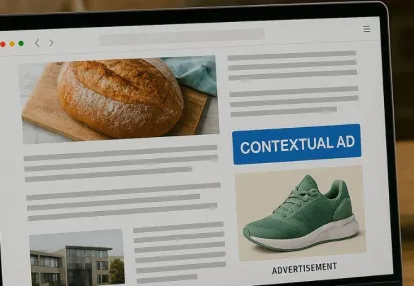
Our spy tools monitor millions of native ads from over 60+ countries and thousands of publishers.
Get StartedWelcome to the dynamic world of native advertising, a crucial part of today's digital marketing landscape. If you're not familiar with this term, native advertising involves seamlessly blending promotional content into a platform's organic content. The main goal is to provide valuable insights in a non-promotional way, enhancing user experiences while also promoting a brand or product.
In this article, we'll explore several successful native advertising campaigns and how they have had a significant impact on different industries. By using this innovative form of advertising, brands can drive both innovation and consumer engagement, thereby reshaping their respective sectors.
For example, by leveraging tools like Anstrex Native, companies can gain deep insights into profitable native ads and fine-tune their own campaigns for maximum effectiveness. Anstrex allows businesses to spy on their competition's successful native advertisements, providing valuable data to inform their own strategies.
With an increasingly discerning audience that prefers subtle yet powerful narratives over blatant promotion, successful native advertising campaigns are not just an option - they're essential for brands aspiring to make a lasting impact in their industry.
Storytelling is the heart and soul of successful native advertising campaigns. It's not just about selling a product; it's about creating a story that deeply connects with the audience, making them feel like they're a part of something bigger. The role of storytelling in native advertising cannot be emphasized enough—here's why:
By telling stories, brands become relatable. You see your own experiences reflected in the narrative, and this familiarity breeds connection.
A story can evoke emotion, whether it's joy, nostalgia, or inspiration. When you feel something, you're more likely to remember—and favor—the brand behind the story.
Authentic narratives foster trust. Industry experts agree that when you recognize genuine storytelling, you perceive the associated brand as more trustworthy.
Consider Apple's "Shot on iPhone" campaign—an exemplary instance where user-generated content formed the crux of a native ad campaign. The narrative was simple yet powerful: real people capturing extraordinary moments on their iPhones. This strategy not only showcased the camera quality but also celebrated creativity among iPhone users.
"The best camera is the one you have with you." - Chase Jarvis
Another example is Dove's "Real Beauty" campaign. Here, storytelling went beyond traditional advertising by starting conversations about beauty standards. The campaign featured real women, not models, discussing their perceptions of beauty—a topic close to many hearts.
"No matter how plain a woman may be, if truth and honesty are written across her face, she will be beautiful." - Eleanor Roosevelt
For a seamless brand experience within native ad formats:
Through these methods, a well-crafted narrative captures attention and sustains it, leading to a memorable and impactful brand experience.
Successful native ad campaigns are becoming more and more influential in the retail industry. They use storytelling to connect with consumers in a subtle yet powerful way. These campaigns go beyond just selling products; they offer a story that resonates with the audience's lifestyle and aspirations. One industry that has seen a big impact from this type of advertising is e-commerce.
The collaboration between Airbnb and Pantone is a great example of how native advertising can change the retail industry. They took Pantone's Color of the Year and combined it with Airbnb's travel experiences to create a campaign that was unlike anything traditional marketing would have done.
Campaign Strategy and Objectives:
Campaign Creatives and Impact:
Results Achieved:
Key Takeaways for Other Brands:
This case study shows how successful native ad campaigns in the retail industry can benefit from fresh ideas that challenge traditional advertising. By including elements from popular culture and focusing on building real relationships with users, retail brands can use native advertising to drive sales growth.
Successful native ad campaigns are not just limited to the retail sector and have been making waves in the tech industry as well. A prime example of this is the innovative approach adopted by Squarespace, a website building and hosting company, which has effectively leveraged native advertising to boost brand awareness and drive product adoption.
Squarespace took its native advertising efforts to a whole new level with its 'Make It Real' campaign. The highlight? Keanu Reeves, an iconic Hollywood actor, was seen riding a motorcycle through the desert, all while narrating his journey of building a website using Squarespace.
Squarespace's objective was to emphasize on its user-friendly features that enable individuals to create professional websites without needing any technical expertise. By partnering with Keanu Reeves, who himself had used Squarespace for his own motorcycle company, the brand was able to create a relatable narrative. Throughout the ad, Reeves is seen enjoying the process of creating a website - something that Squarespace aimed to communicate to its potential users.
The strategic choice of partnering with Reeves added credibility to Squarespace’s message of empowerment. The ad resonated with tech enthusiasts who admired Reeves not only as an actor but also as an entrepreneur who had successfully built his own business online using Squarespace.
The campaign resulted in increased visibility for Squarespace within the tech industry and beyond. Thanks to its engaging storytelling and effective use of celebrity endorsement, the 'Make It Real' campaign made a significant impact on Squarespace's market position.
The success of Squarespace’s 'Make It Real' campaign serves as an inspiration for other tech companies looking to leverage the power of native advertising. The key takeaway here is that a well-crafted narrative, backed by a credible endorsement, can resonate effectively with your target audience and position your brand as a trusted solution-provider in the industry.
The health and wellness industry is always looking for new ways to combine content with user experience, and native ad campaigns are key in achieving this. In the health and wellness industry, native advertising examples not only promote products but also highlight how they can improve people's lives through interesting and educational content.
The collaboration between Headspace, a meditation app, and Nike Run Club, a platform for runners, is a great example of how mental fitness and physical exercise can work together effectively. This partnership aimed to address the needs of athletes as a whole by promoting mental well-being alongside their regular running routines.
The integration of Headspace's guided mindfulness exercises into the Nike Run Club app was a significant step forward in creating a comprehensive health-focused user experience. It allowed runners to access mental training tools that complemented their physical workout routines.
The partnership between Headspace and Nike Run Club produced measurable outcomes that demonstrated the success of the campaign:
Through this strategic partnership, Headspace and Nike Run Club provided value to consumers beyond just their products. They introduced a new perspective in the health and wellness industry by highlighting the significance of mental fitness in an athlete's routine. This case study showcases how successful native ad campaigns can use authenticity and usefulness to build trust and motivate users in the health and wellness industry.
The travel and hospitality industry thrives on the ability to evoke feelings of wanderlust and adventure. Successful native ad campaigns in this sector leverage visual storytelling to transport potential customers to destinations they yearn to explore. This section delves into a case study that exemplifies how native advertising can transform the way people perceive travel opportunities.
Partnership Overview:
National Geographic, a name synonymous with exploration and stunning visuals, joined forces with Airbnb Experiences to curate a series of travel adventures. This collaboration aimed to bring authentic, local experiences to travelers seeking more than just accommodations.
Campaign Strategy:
Visual and Narrative Impact:
Business Impact:
The results spoke volumes about the effectiveness of integrating compelling visuals with inspiring narratives. The campaign not only elevated brand perceptions but also prompted tangible actions from consumers eager to embark on their next journey.
By engaging customers through authentic stories that resonate with their desires for unique travel experiences, both National Geographic and Airbnb demonstrated how strategic partnerships can lead to mutual success in the travel/hospitality industry.
This native advertising example underscores the power of combining strong imagery with impactful storytelling to leave a lasting impression on audiences. Such campaigns not only boost business outcomes but also create memorable experiences that resonate deeply with consumers' aspirations.
The finance and banking sector is no stranger to the transformative power of native advertising. With its ability to blend seamlessly into the user experience, native ads have proven effective in establishing thought leadership and providing value to consumers. One such successful native ad campaign can be seen with American Express's 'Small Business Saturday'.
American Express launched a unique initiative known as 'Small Business Saturday' in 2010. This event, which takes place on the post-Thanksgiving shopping holiday, was designed to encourage consumers to shop at local businesses. The initiative served two purposes: promoting local businesses and reinforcing American Express's commitment to supporting small businesses.
The campaign was promoted through a series of native ads seamlessly integrated into online publications. These ads offered financial tips for small business owners, reinforcing American Express's image as a thought leader in the finance industry. The content was highly relevant and provided value to its target audience – small business owners.
Key Highlights
The 'Small Business Saturday' campaign was highly effective in driving both brand affinity and merchant transactions for American Express. Not only did it reinforce the brand's image as a supporter of small businesses, but it also encouraged consumers to use their American Express cards when shopping at these local establishments.
Impact
By integrating their advertising efforts into relevant content and providing clear value to their target audience, American Express was able to create a successful native ad campaign. This case serves as an excellent example for other brands in the finance/banking industry, demonstrating the potential of native advertising when used effectively.
In the fast-paced world of digital advertising, innovative trends are continually shaping the landscape. One significant development is the rise of programmatic native advertising. This approach uses advanced algorithms and real-time bidding to automate the buying and selling of native ads. Not only does it streamline the process, but it also allows for more precise targeting, ensuring that your content reaches its intended audience.
Leading brands are leveraging programmatic native to bypass ad-blockers and deliver high-quality content that seamlessly blends with user experiences. By prioritizing customer-centric strategies, these brands are achieving higher engagement rates and increased brand affinity.
Example: American Express 'Small Business Saturday' campaign championing local businesses transparently promoted as sponsored content.
Another prominent trend in native advertising revolves around transparency. Trust plays a critical role in consumer-brand relationships. As such, being open about sponsored content has become essential for sustained industry growth. Consumers appreciate honesty and clear labeling of native ads helps foster trust while maintaining the integrity of the content.
These emerging trends provide exciting opportunities for businesses to connect with audiences in meaningful ways while staying ahead in the competitive advertising arena.
In the era of digital marketing, data-driven native advertising has emerged as an effective strategy to connect with customers. Brands are using data to shape their native advertising strategies, using what they know about their audience to create ads that really hit home.
Knowing who you're talking to is crucial. By looking at things like age, gender, and interests, brands can create targeted ads that speak directly to their consumers' needs and interests. For example, a company selling eco-friendly cleaning products might use data to find out that their audience is interested in sustainable living, and then create native ads that highlight the environmental benefits of their products.
While data is important, it's not everything. Native advertising still needs to be creative and engaging in order to really make an impact. Here are some tips for finding the right balance between data and storytelling:
By combining data with storytelling, brands can create native ads that really resonate with their audience:
"We used our customer insights to understand what matters most to our audience - saving time and reducing stress. With this knowledge in hand, we crafted a native ad campaign featuring busy parents who found our meal prep service to be a game-changer. The result? A 30% increase in conversions and a stronger bond with our target market."
"Our data showed us that our audience is passionate about fitness and outdoor activities. Instead of focusing solely on product features, we decided to tell the story of an avid hiker who used our hiking boots to conquer challenging trails. This approach not only drove sales but also built brand loyalty among outdoor enthusiasts."
"We discovered through data analysis that our target audience is concerned about the environment and actively seeks out sustainable products. Armed with this knowledge, we created native ads showcasing the eco-friendly features of our clothing line. The campaign was a hit, resulting in a 40% increase in website traffic and a surge in sales."
By using data to understand their audience and then weaving that knowledge into their storytelling, brands can create native ads that truly connect with their customers.
After examining these case studies, it is clear that native advertising is more than just a passing fad. It is a powerful tool that is transforming various industries. Native ads have the ability to seamlessly blend with content and provide valuable experiences for consumers, resulting in incredibly high levels of engagement and conversion rates.
Every industry, from retail and e-commerce to technology, health and wellness, travel and hospitality, and finance and banking, is experiencing a change in consumer behavior due to innovative native advertising campaigns.
The examples mentioned earlier highlight how different brands have successfully utilized native advertising strategies to achieve their goals:
These real-life examples offer valuable insights for businesses seeking to implement effective native advertising strategies:
As we move forward, it is important to recognize that native advertising presents an opportunity for brands to establish authentic connections with their audience and drive industry-wide innovation.
While embarking on your own native advertising journey, keep these key lessons in mind:
Remember, native advertising is not just about promoting a product or service; it's about crafting a narrative that truly speaks to your target market and fosters meaningful connections.
Receive top converting landing pages in your inbox every week from us.
How-To
Native ads can do more than drive clicks—they can build long-term brand loyalty. Learn how to use authentic storytelling, strategic placement, and audience targeting to strengthen trust during year-end campaigns. Discover how subtle, value-driven messaging keeps customers engaged beyond the holidays. Ideal for marketers aiming to turn seasonal buyers into loyal brand advocates.
Marcus Chen
7 minDec 15, 2025
Must Read
As third-party cookies fade away, contextual targeting is making a powerful comeback. Learn how to leverage native ads that align with user intent and content relevance to maintain high engagement and conversions. Discover modern tools and tactics that make cookie-free targeting both precise and scalable. Ideal for advertisers seeking privacy-friendly ways to drive performance in 2025 and beyond.
Liam O’Connor
7 minDec 9, 2025
Recently Updated
Native ads can make or break your holiday marketing success. Explore how to evaluate your recent campaigns and identify what worked—or what fell short—with native advertising. Learn key optimization tactics to boost engagement, strengthen audience trust, and increase conversions in future promotions. Ideal for marketers aiming to refine their ad strategies after the holiday rush.
Elena Morales
7 minDec 1, 2025




